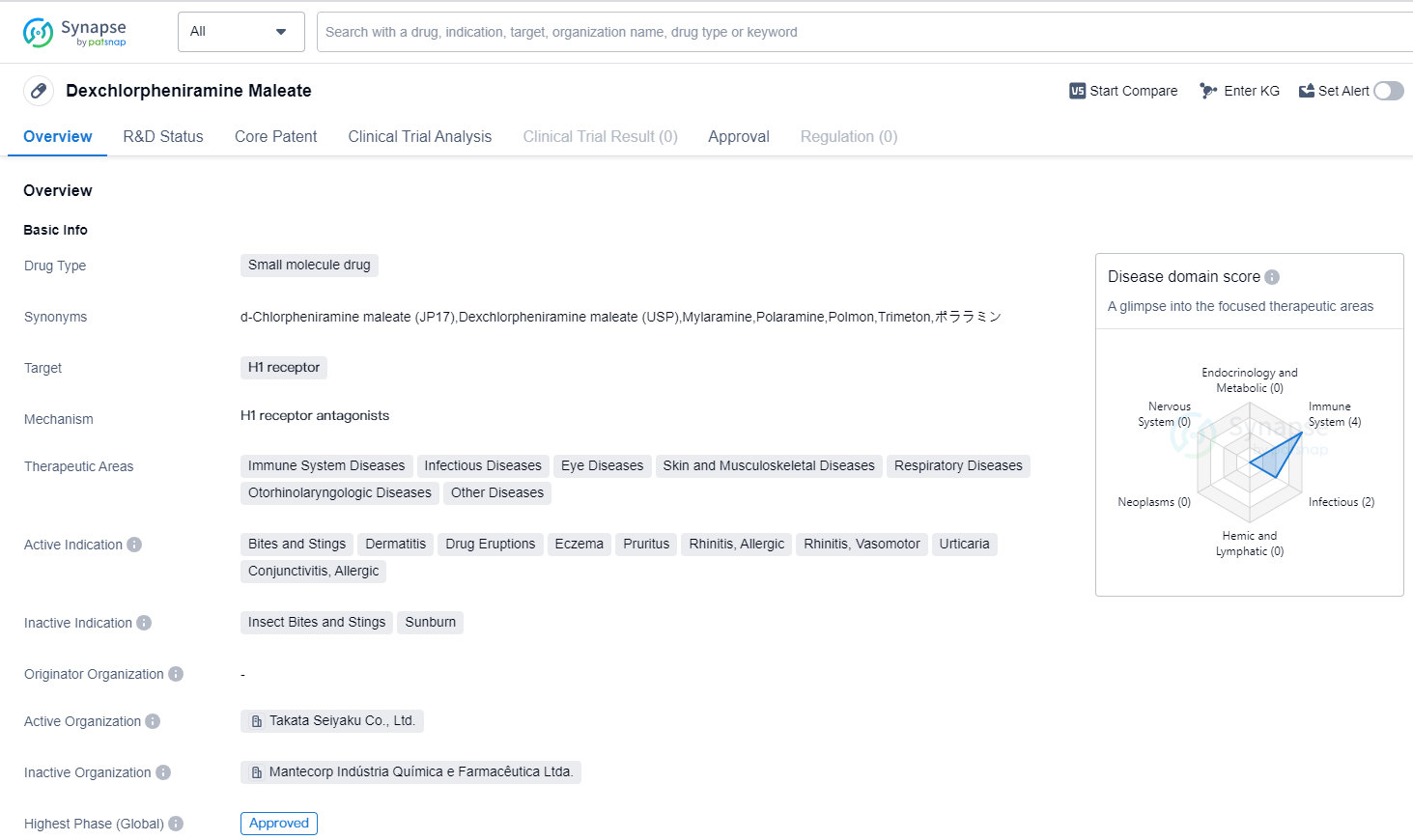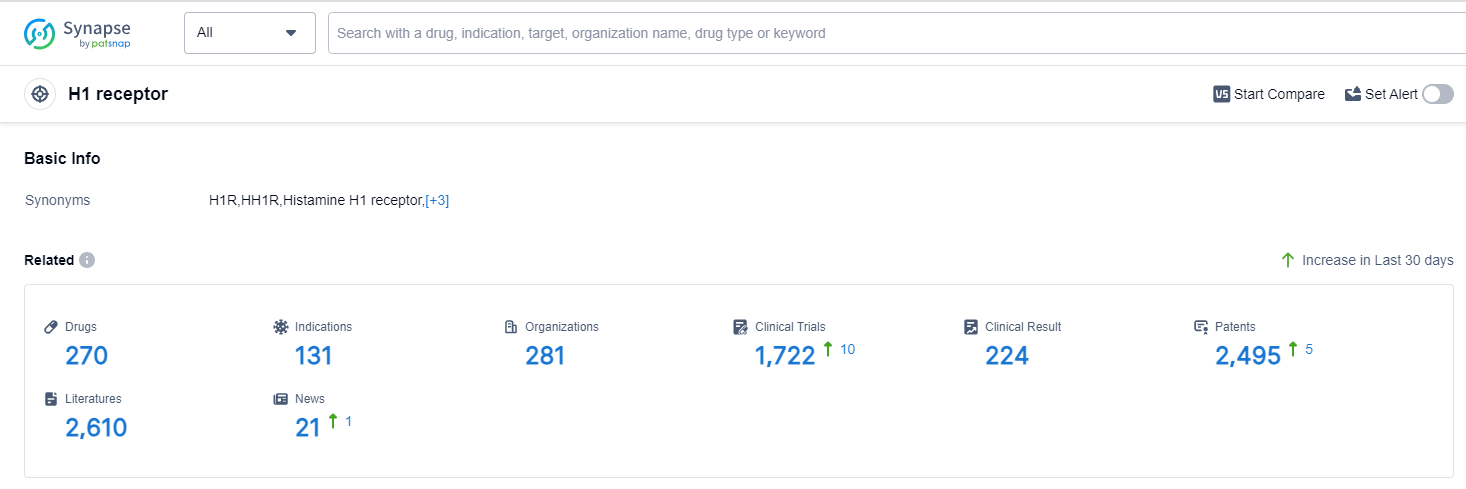Unleashing the Power of dexchlorpheniramine maleate: A Comprehensive Review on R&D Breakthroughs
Dexchlorpheniramine maleate's R&D Progress
Dexchlorpheniramine Maleate is a small molecule drug that primarily targets the H1 receptor. It has been approved for use in various therapeutic areas, including immune system diseases, infectious diseases, eye diseases, skin and musculoskeletal diseases, respiratory diseases, otorhinolaryngologic diseases, and other diseases. The drug has shown efficacy in treating a range of conditions such as bites and stings, dermatitis, drug eruptions, eczema, pruritus, allergic rhinitis, vasomotor rhinitis, urticaria, and allergic conjunctivitis.
The drug received its first approval in May 1964 in Japan, making it one of the earliest approved drugs in the market. Since then, it has gained global recognition and acceptance. Dexchlorpheniramine Maleate has undergone rigorous testing and evaluation to ensure its safety and efficacy, leading to its approval for use in various countries worldwide.
As a small molecule drug, Dexchlorpheniramine Maleate is designed to interact with the H1 receptor, which plays a crucial role in mediating allergic responses. By targeting this receptor, the drug can effectively alleviate symptoms associated with allergic reactions, such as itching, inflammation, and nasal congestion.
The therapeutic areas in which Dexchlorpheniramine Maleate is indicated highlight its versatility in treating a wide range of diseases. Immune system diseases, infectious diseases, and respiratory diseases are prevalent conditions that often require effective treatment options. Additionally, eye diseases, skin and musculoskeletal diseases, and otorhinolaryngologic diseases can significantly impact a patient's quality of life, making Dexchlorpheniramine Maleate a valuable therapeutic option.
The drug's long history of use since its first approval in Japan demonstrates its safety and efficacy profile. Its approval in multiple countries further attests to its global recognition and acceptance within the medical community.
👇Please click on the image below to directly access the latest data (R&D Status | Core Patent | Clinical Trial | Approval status in Global countries) of this drug.
Mechanism of Action for dexchlorpheniramine maleate: H1 receptor antagonists
H1 receptor antagonists, also known as H1 antihistamines, are a class of drugs that block the action of histamine at the H1 receptors. Histamine is a chemical released by the body during allergic reactions, causing symptoms such as itching, sneezing, and watery eyes. H1 receptor antagonists work by binding to the H1 receptors on cells, preventing histamine from binding and exerting its effects.
From a biomedical perspective, H1 receptor antagonists are commonly used in the treatment of allergies, such as hay fever, allergic rhinitis, and allergic conjunctivitis. They help alleviate symptoms associated with allergic reactions by reducing the effects of histamine. These drugs can provide relief from itching, sneezing, nasal congestion, and other allergy symptoms.
Examples of H1 receptor antagonists include cetirizine, loratadine, fexofenadine, and diphenhydramine. They are available over-the-counter or by prescription, depending on the specific drug and its formulation. It is important to note that while H1 receptor antagonists can effectively relieve allergy symptoms, they may cause side effects such as drowsiness, dry mouth, and blurred vision in some individuals.
Drug Target R&D Trends for dexchlorpheniramine maleate
The H1 receptor, also known as the histamine H1 receptor, plays a crucial role in the human body. It is primarily found in smooth muscle cells, endothelial cells, and nerve cells. Activation of the H1 receptor by histamine leads to various physiological responses, including vasodilation, increased vascular permeability, bronchoconstriction, and stimulation of sensory nerve endings. These responses are involved in allergic reactions, inflammation, and immune responses. Antagonists of the H1 receptor, commonly known as antihistamines, are widely used to treat allergies, hay fever, and other conditions associated with excessive histamine release. Understanding the role of the H1 receptor is essential for developing effective treatments for allergic and inflammatory disorders.
According to Patsnap Synapse, as of 14 Sep 2023, there are a total of 270 H1 receptor drugs worldwide, from 281 organizations, covering 131 indications, and conducting 1722 clinical trials.
The analysis of the target H1 receptor reveals that GSK Plc, Sanofi, and Bayer AG are the companies growing fastest under this target. Rhinitis, Allergic, Common Cold, and Urticaria are the most common indications for approved drugs. Small molecule drugs are progressing most rapidly, indicating intense competition. China is the country developing fastest under the target H1 receptor, followed by the United States and Japan. The current competitive landscape is characterized by multiple companies with approved drugs, indicating a competitive market.
👇Please click on the picture link below for free registration or log in directly if you have a freemium account, you can browse the latest research progress on drugs, indications, organizations, clinical trials, clinical results, and drug patents related to this target
Conclusion
In summary, Dexchlorpheniramine Maleate is a small molecule drug that targets the H1 receptor. It has been approved for use in various therapeutic areas, including immune system diseases, infectious diseases, eye diseases, skin and musculoskeletal diseases, respiratory diseases, otorhinolaryngologic diseases, and other diseases. With its first approval in Japan in 1964, Dexchlorpheniramine Maleate has established itself as a reliable and effective treatment option for a range of conditions, providing relief to patients worldwide.






